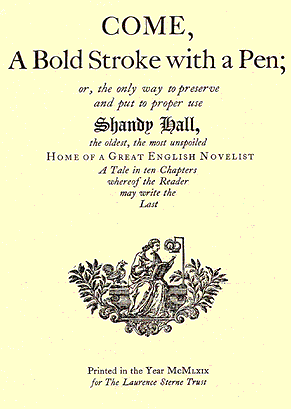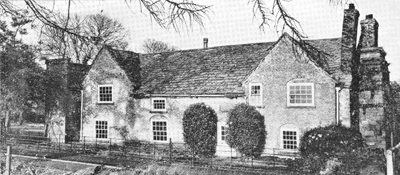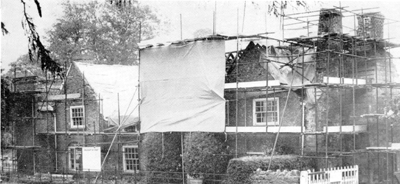
Come, a bold stroke ...

Adapted from a booklet published in July 1974 to raise funds for the restoration of Shandy Hall. All the figures mentioned here are now outdated.
CHAPTER ONE
'PULL it down and build again' was the advice five years ago of those who know the price of things but not their value.
True, the five-hundred-year-old house was feeling its age. Dry rot and the death-watch beetle had bitten deep into its bones. By a miracle the massive stone slates, weighing fifty tons, remained still poised on the rotted beams beneath.
TOO often in these affairs today the bulldozer wins. Too much of the past has gone already. But this piece of it was really worth fighting for. An oak-framed open hall built about 1450 at Coxwold in the North Riding of Yorkshire; cased in red brick and split into rooms, some panelled, in the 17th century; given an elegant 'new look' in the 18th and hardly altered since, it had survived into the 20th as a house of strange and compelling fascination on the outskirts of one of the loveliest unspoiled villages in England. Deservedly it was starred as a Building of Special Architectural or Historic Interest.
BUT it was more than that. In 1760 it became the home, and remained so until his death in 1768, of that most eccentric of parsons, the Rev. Laurence Sterne. In this 'philosophical hut' or Shandy Hall as he called it (shandy was a local word meaning odd, unpredictable) he chose as his study a snug room warmed by the great mediaeval kitchen chimney where when the mood took him he would sit up all night writing two of the wittiest, wisest, most original, most influential novels in the world: The Life and Opinions of Tristram Shandy, Gentleman and A Sentimental Journey through France and Italy.
UNTHINKABLE not to rescue this house which Sterne loved, where he was happiest, where laughter that will last for ever was born. To buy it, restore it, and make it a living Sterne Museum, the LAURENCE STERNE TRUST was set up and recognised as a charity by the Department of Education and Science. Plans and estimates were prepared, and in April 1968 the TRUST launched an appeal for £25,000.
So far, £17,500 has been raised. In August 1968 the difficult, delicate task of restoration began. It has continued since. By now the TRUST has:
-
Paid for the freehold;
Dismantled and soundly rebuilt the entire roof structure;
Treated all timbers against fungal and insect infestation;
Reinforced the fabric with hidden steel plates and girders; Underpinned external walls and formed a drained dry-area alongside; Rebuilt much 17th- and 18th-century brickwork using matching hand-made bricks;
Preserved the 'Shandean' shape of an old chimney-stack by inserting a flexible flue, steel rods, and cement; Repaired or renewed all windows, replacing broken panes with Crown glass; Replaced the original stone slates, piecing in damaged ones with similar Yorkshire slates.
A BONUS. Behind panelling in the solar or private apartment at the upper end of the old open hall, wall paintings dating from the reign of Henry VIII have come to light--a great rarity in north-country domestic dwellings. When the panelling is replaced it will be hinged so that the paintings can be shown.
ANOTHER bonus. The 18th century alterations are now known to have been ordered by Sterne himself. Most are still intact, among them hob-grates with early Adam decoration, paintwork still in the colours he chose, a coved china-recess in dark green heightened with gold, a curious Georgian façade overlooking his favourite garden. Shandy Hall has changed little since Sterne left it. It stands revealed today as the earliest, most intimate, most unspoiled home of any great English writer.



Shandy Hall before, during and after the restoration of the roof and external fabric.

One of the new fireplaces added by Sterne in 1767, probably with the help of the York architect John Carr.

On the original mediaeval wall of Sterne's bedroom, behind 18th-century panelling, the first of several wall paintings was found. It shows a gentleman-at-arms holding a pole-axe; his costume suggests a date of about 1520.
So far, so good. Shandy Hall has emerged from its scaffolding weathertight and good for centuries more, yet still the same house of captivating charm and oddity. The restoration of the roof and external fabric has been a brilliant success.
Now for the interior. Panelling and other woodwork must be repaired, damp courses and modern services tactfully installed, plastering and decorating done, shelves and display-cases provided for the remarkable Sterne Collection promised on permanent loan (it includes the only complete library of early editions of Tristram Shandy in the world). To do all this with the skill and care already bestowed on the roof and exterior, the Trust urgently needs that remaining £7,500.
Will you help to write the tenth and triumphant last chapter in the rescue and revival of Shandy Hall--now?
For information on how you can help, please contact
The Curator, Patrick Wildgust, at [email protected]